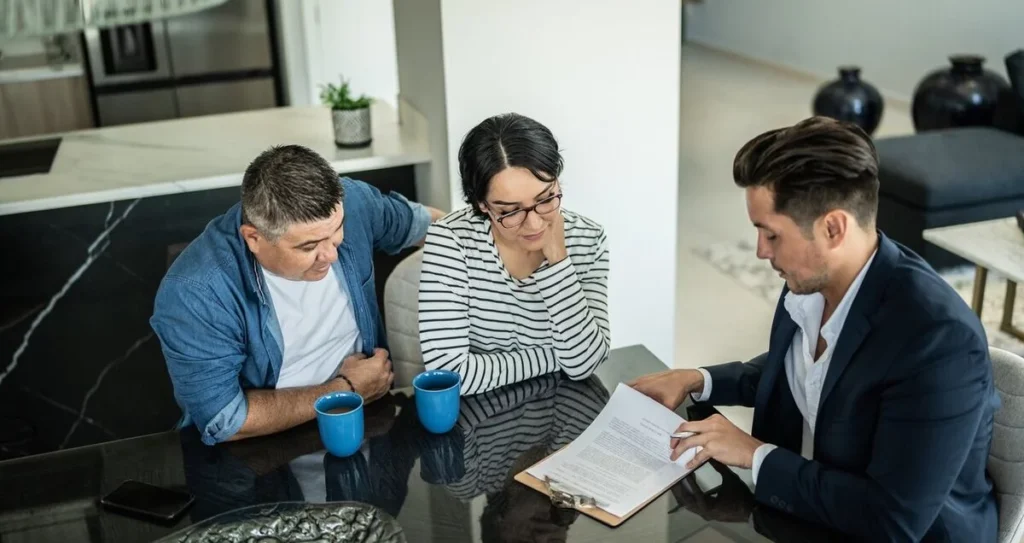When applying for a buy-to-let mortgage, it’s important to understand what criteria will be considered to determine your eligibility. This article will provide a comprehensive overview of buy-to-let mortgage eligibility criteria.

Buy-to-Let Mortgage Eligibility Criteria
What buy-to-let mortgage eligibility criteria do you need to meet? Find out here. We go through rental income stress tests, deposit requirements and more.
speak to a mortgage advisor
Fill out this enquiry form and we’ll contact you to book a free call with one of our mortgage experts.
"*" indicates required fields
Buy-to-let mortgages are a type of mortgage specifically designed for individuals who want to invest in property and rent it to tenants, usually with the intention of making a profit.
Contents
What Is a Buy-to-Let Mortgage?
A buy-to-let mortgage is a type of secured loan designed for those interested in purchasing a property as an investment. This loan enables someone to borrow money from a lender in order to purchase a property with the intention of renting it out and earning an income from it. This is a popular way of generating money and can be a great source of passive income.
Understanding the difference between buy-to-let mortgages and other types of home loans is important, as they have their own lending criteria, eligibility requirements and affordability assessments. Knowing these distinctions can help you make a more informed decision when choosing the right mortgage for your needs.

What Are the Different Types of Buy-to-Let Mortgages?
When it comes to getting a buy-to-let mortgage, the most popular products on the market are interest-only. However, it is possible to get a repayment buy-to-let mortgage if you meet certain criteria. Here’s a quick overview of both as well as other things to consider when choosing a deal such as mortgage rate and investing through a limited company.
Interest-Only
When you opt for an interest-only payment plan, it usually costs less on a monthly basis than a repayment mortgage as you only make interest payments each month – not interest payments and capital repayments. This is an advantageous solution if you want to reduce your outgoings in the short term. However, once you reach the end of the mortgage term you’ll have to pay back the total amount you originally borrowed when you purchased the property. This is done via a suitable repayment vehicle – e.g. selling the property.
Repayment
Buy-to-let repayment mortgages are much less popular than interest-only ones. This is because in order to qualify for a buy-to-let mortgage, your monthly rental income needs to be at least 125% of the monthly mortgage payments and obviously, if you’re making a mortgage payment in addition to an interest payment each month, your rental income will need to be much higher.
If your rental yield is particularly high and/or you have only taken out a small mortgage with smaller monthly payments, then a repayment buy-to-let mortgage may be more suitable for you.
Rates
There are many different rate options for buy-to-let mortgages, including fixed, tracker, discount and capped interest rates. The right buy-to-let mortgage rate for you will depend on your situation and needs. Your mortgage broker can help you choose the best rate for your circumstances.
Personal Name vs Limited Company
You can take out a buy-to-let mortgage in your personal name as a private landlord or through a limited company set up specifically for investing in property. Investing in buy-to-let property through a limited company can offer certain tax benefits to certain people, as you don’t pay Income Tax on the rent you receive from tenants, instead you pay Corporation Tax. Find out what option is right for you by speaking to one of our expert buy-to-let mortgage brokers.
Our buy-to-let affordability calculator can help you assess your situation. You can also try our mortgage repayment calculator to quickly compare the cost of a repayment plan to an interest-only mortgage.
Eligibility Criteria for Buy-to-Let Mortgage Products
Buy-to-let mortgages can vary from lender to lender, but there is a range of criteria that many will assess. Generally speaking, these are grouped into the following categories.
Personal Criteria
There are certain personal criteria for buy-to-let mortgages that you must meet. These include factors such as the following:
- Credit History – if you have a less-than-perfect credit history, obtaining a competitive mortgage deal can be difficult. But the extent and severity of your financial concerns will determine the success or failure of your loan application. Fortunately, if you’re worried about how this may affect you, there are still buy-to-let bad credit mortgage specialists that may consider your application
- Income – unlike residential mortgages, affordability for buy-to-let mortgages isn’t incredibly significant. Buy-to-let affordability checks usually include stress testing rental income against the mortgage payments, rather than your own personal income. However, some lenders will have an income threshold of £15k – £25k to ensure that the mortgage can still be paid in the event of any rental voids. Most lenders will have a £0 threshold as buy-to-let mortgages should be self-sustaining
- Age – generally, lenders require a minimum age of 21 to 25 to obtain a buy-to-let mortgage and it’s often anticipated that the loan must be fully repaid by the time you reach 75 – 86. However, some lender don’t have this limit. Furthermore, some lenders won’t want to lend to applicants after the age of 80. If you do want to take out a buy-to-let mortgage later in life then the lender will want to know your succession plan for the property. This is especially true for portfolio landlords
Property Criteria
In addition to some personal criteria, lenders also assess the property. Here are some factors lenders will consider:
- Property type – lenders have their rules regarding the properties they’re willing to finance. While many lenders may be hesitant when it comes to non-standard construction properties for investment purposes, some may take a more lenient approach. If you’re considering investing in HMO (House of Multiple Occupancy) properties, be aware that not all lenders are willing to finance them. For larger properties requiring a license, finding the right lender can prove tedious. But don’t worry as there are lenders out there who provide mortgages on these types of investments and a mortgage broker like John Charcol can help you find them
- Rental yield – when mortgage providers consider your loan application, rental yield is a key factor. Monthly payments are often expected to be covered by the rent you’ll receive from tenants, so lenders might ask for an estimation of income from an accredited letting agent. This calculation should be based on market rental values of similar properties in the area, as well as the current condition of the property. Lenders normally stress test the rental income, requiring that it as least 125% of the monthly payments
- Location – the degree to which your lender focuses on the location of your rental property will be determined by what you’re planning to do with it. If the intention is only to provide AST (Assured Shorthold Tenancies), then given that the market rate for this area is fair, its exact spot won’t be overly important
- Tenant type – if you’re contemplating renting out your property to students or holidaymakers, keep in mind that you may need a specific lender or mortgage product that caters to that level of risk. Be clear about your intentions with the property and your mortgage adviser will be able to find you the right deal for your situation
How Much Deposit Do I Need for a Buy-to-Let Mortgage?
When looking to invest in a buy-to-let mortgage, the minimum down payment can range from 20% – 40%. Typically, this will be 25%. This means that if you’re seeking a property worth £250,000 then you should be prepared to provide an initial deposit of between £50,000 (20%) and £100,000 (40%). If you arrive at the average 25% deposit, this would mean a down payment of £62,500.
The size of the deposit is significant for all kinds of mortgages, as it’s a key factor in obtaining the right mortgage and interest rates for your buy-to-let investment. A larger deposit often gives you access to more and better deals with lower interest rates – this can be particularly useful if you have bad credit and would otherwise find your options limited.
How Much Can I Borrow for a Buy-to-Let Mortgage?
When determining how much you can borrow, it’s important to take into account the rental income expected. To gain an understanding of what rent should be charged, consult with local letting agents and look at rents for similar properties.
For instance, if you were looking to buy a property worth £250,000 and the expected rent was £1,300pcm, your expected yield would be 6.24%. This is considered a good yield, so the chances of being approved are higher.
For a basic rate taxpayer or landlord purchasing a buy-to-let through a limited company, the rental income you can charge must usually be 125% of your monthly mortgage payments. For example, if your monthly payment is £600 then you need to have a minimum rent revenue of £750 per month.
For a higher rate taxpayer, the rental income must be 145% of your monthly mortgage payments. For example if your monthly payment is £600 then you need to have a minimum rent revenue of £870.
Higher rent payments can allow you to borrow more and secure a larger loan.
For more guidance on how much you can borrow, you can use our handy mortgage calculator.

Can You Get a Buy-to-Let Mortgage if You’re a First Time Buyer?
Yes, it’s possible for first time buyers to secure a buy-to-let mortgage and begin investing in property. There are some things to keep in mind, though:
- Your deposit will typically need to be at least 25% of the property’s purchase price
- You’ll have to say goodbye to the advantages that only first time buyers enjoy, such as the first time buyer Stamp Duty exemption. Since you won’t be residing in your initial property purchase but you’re also not purchasing an additional or second property, you’ll pay Stamp Duty at the standard rates
- When you apply for a buy-to-let mortgage as a first time buyer, the lender will scrutinize the application in great detail in order to ensure that it’s not a “backdoor resi”. A “backdoor resi” is where someone tries to purchase a property they intend to live in under the guise that it will be operating as a buy-to-let in order to borrow more than their personal income would allow
These are some of the key considerations when looking for a buy-to-let mortgage as a first time buyer. As much as you may want to jump straight into property investment, it’s important to research and plan so your investment is successful, profitable and doesn’t hinder you in the future. Speak to a mortgage broker on 0808 273 2191 to find out about your options in this situation.
How Can I Secure the Best Interest Rates on a Buy-to-Let Mortgage?
The best way to get the most favourable interest rates when taking out a buy-to-let mortgage is to shop around and compare different lenders. Different lenders will offer different packages, so it’s important to weigh up all the options before you commit.
Wondering how you can do this? Go to an independent, specialist mortgage broker such as John Charcol. We have access to all mortgage products on the market, and we can find the most competitive deals available. We also understand the intricacies of the buy-to-let market, so we can provide tailored advice and guidance to ensure you get the best deal possible.
What Is a Portfolio Mortgage?
A portfolio mortgage is a single mortgage that is secured against 2 or more properties.
Alternatively a portfolio landlord is a landlord with 4 or more investment properties.
Speak to one of our mortgage advisers if you’d like to learn more about expanding your portfolio and how it all works.
Do I Need Insurance as a Landlord?
Buy-to-let mortgage lenders will require that buildings insurance is taken out on a property. They won’t grant a mortgage without it. Buildings insurance is mandatory and covers any loss or damage to your rental property in case of a fire, flood, or other unexpected event. Whether it’s up to you to arrange buildings insurance will depend on your situation:
- If you’re purchasing a leasehold flat then you will likely pay towards the building insurance as part of the service charge
- If you’re purchasing a freehold house then it will be up to you to arrange buildings insurance
Some other types of insurance to be aware of as a landlord include:
- Contents Insurance – if you’re letting furnished properties, this will cover contents that belong to you against loss or damage due to fire, storm, theft, and other causes. You can arrange this or make it a condition of the tenancy agreement
- Liability Insurance – sometimes referred to as public liability insurance, this covers costs incurred if a tenant or third party is injured on the property or their belongings are damaged while they are there. The service charge you pay on a leasehold will usually take liability insurance and buildings insurance into consideration
- Rental Protection Insurance – this covers the costs of lost rent and legal fees if a tenant fails to pay, or if you’re unable to find tenants for an extended period of time. It is up to you to arrange this to protect yourself against rental voids
It’s important to note that there may be additional insurance policies available depending on your particular situation as a landlord. Be sure to do your research and choose the policy that best suits your needs.
Buy-to-Let Mortgage Eligibility Criteria Next Steps
Investing in property can be a great way to make money and build your wealth. But it’s important to understand the criteria you must meet to get competitive mortgage deals, as well as choose the right property and the mortgage product for your needs.
With the right preparation and guidance from an independent mortgage broker like John Charcol, you can confidently navigate the buy-to-let market and secure a deal that suits you. This will help to ensure that you make a wise investment and get the best return on your money. Get in touch with us today on 0808 273 2191 to see how we can help you.
